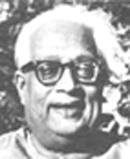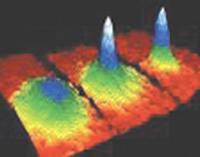Einstein Lays Theoretical Foundation for BECs
Einstein had achieved worldwide fame with his theory of general relativity, although his personal life was far from idyllic. His wife, Mileva, complained that he had no time for her in the midst of his fame, adding, "I am very starved for love." For his part, Einstein felt increasingly suffocated in his marriage and embarked on a love affair with his cousin, Elsa Löwenthal. Mileva and Albert separated in 1914, after bitter arguments, and divorced in 1919. That same year he married Elsa, and settled in with her and her two grown daughters by a previous marriage.
 Satyendra Bose |
Scientifically, however, he was still going strong. Einstein’s 1917 paper detailing a quantum theory of radiation sowed the seeds for quantum electrodynamics and quantum optics, cavity quantum electrodynamics, and the processes of spontaneous and stimulated emission – the last of which led, later on, to the invention of masers and lasers by other physicists. And it also provided the underpinnings for a theoretical new state of matter.
Einstein’s theory of radiation provided a complete characterization of the light quantum’s specific particle properties. However, he didn’t immediately work out the statistical mechanics of those particles–an omission that has surprised several science historians, since he based his 1905 paper on the energy quantization of radiation on a study of the entropy of thermal radiation.
That omission was remedied in 1924, when he received a paper from a colleague, Satyendra Nath Bose, that successfully derived Planck’s law by treating photons as indistinguishable particles, rather than individual quanta. Einstein promptly forwarded the paper for publication, and applied the same reasoning as Bose used to a gas of indistinguishable atoms. The result was the creation of Bose-Einstein statistics. Many physicists regard this work as Einstein’s last major contribution to physics.
 A Bose-Einstein Condensate |
Einstein and Bose used their new method to predict the possibility of a new form of matter, dubbed a Bose-Einstein condensate (BEC). They surmised that the wavelike nature of atoms might allow them to spread out and even overlap, if they are packed closely enough together. Lowering the temperature reduces the atoms’ speed. If the temperature gets low enough (billionths of a degree above absolute zero) and the atoms are densely packed enough, the different matter waves will be able to “sense” one another and coordinate themselves as if they were one big “monoatom.”
Einstein published a paper on the topic, entitled “Quantum Theory of the Monatomic Ideal Gas,” in the proceedings of the Prussian Academy of Sciences in Berlin, Germany, in January 1925. In August of this year (see Members in the Media), a student at Leiden University’s Lorentz Institute for Theoretical Physics uncovered Einstein’s manuscript for the paper, while reviewing documents in the archive for his thesis on Paul Ehrenfest.
But the technology didn’t yet exist to create such a new state of matter in the laboratory. In the mid-1980s, Stanford University physicist Steven Chu demonstrated laser cooling by weaving a “web” out of infrared laser beams. He called it “optical molasses.” The beams bombard target atoms with a steady stream of photons, whose wavelengths are carefully selected so that they will only be absorbed if they collide head-on with atoms. As the atoms slow down, they cool down to about 10 millionths of a degree above absolute zero.
Carl Wieman, a physicist at JILA/University of Colorado, and his JILA colleague, Eric Cornell, embarked on a five-year quest to produce the first BEC, using a combination of laser and magnetic cooling equipment that Wieman designed himself. While other groups were pouring research dollars into cutting-edge $150,000 lasers, he pioneered the use of simple $200 diode lasers. Using a laser trap, they cooled about 10 million rubidium gas atoms; the cooled atoms were then held in place by a magnetic field. But the atoms still weren’t cold enough to form a BEC, so the two men added a second step, evaporative cooling, in which magnetic fields in a web conspire to kick out the hottest atoms so that the cooler atoms can move more closely together. Evaporative cooling was an old technique; the JILA scientists simply tinkered with it until they got the low temperatures they needed.
Wieman and Cornell made physics history at 10:54 a.m. on June 5, 1995, producing a BEC of about 2000 rubidium atoms that lasted 15-20 seconds. Shortly thereafter, MIT physicist Wolfgang Ketterle achieved a BEC in his laboratory. By September 2001, over three dozen teams had replicated the experiment. Wieman, Cornell and Ketterle shared the 2001 Nobel Prize in Physics for their achievement.
The discovery launched an entirely new branch of physics. BECs enable scientists to study the strange, small world of quantum physics as if they were looking at it through a magnifying glass; a BEC “amplifies” atoms in the same way that lasers amplify photons. Among other things, scientists have used BECs to build an atom laser that releases individual atoms; it could one day be useful to etch tiny patterns on computer microchips. Others hope to build atomic computer circuits that rely on the motion of atoms instead of electrons to store and process information. And in February 1999, researchers at Harvard University found they could slow down light – which normally travels at 669,600,000 MPH—to just 38 MPH by shining a laser beam through a BEC. Two years later they briefly brought light to a complete stop.
©1995 - 2024, AMERICAN PHYSICAL SOCIETY
APS encourages the redistribution of the materials included in this newspaper provided that attribution to the source is noted and the materials are not truncated or changed.
Associate Editor: Jennifer Ouellette
Staff Writer: Ernie Tretkoff
October 2005 (Volume 14, Number 9)
Articles in this Issue

